The group dining intelligent platform market is valued at USD 442.8 million in 2025 and is expected to reach USD 2,266.6 million by 2035, driven by increasing institutional focus on efficient meal service coordination, digital payment integration, and real-time dining operations management. Corporate campuses, university dining halls, government facilities, and hospital cafeterias are increasingly shifting toward centralized, software-based food-service administration to improve throughput, reduce waste, and enhance meal-planning accuracy. Intelligent dining platforms incorporate menu personalization, consumption data analytics, inventory forecasting, and dietary compliance tracking, which are becoming essential for cost-efficient large-scale food service management.
From 2025 to 2030, the market increases from USD 442.8 million to approximately USD 1,002.5 million, adding USD 559.7 million and representing 31 percent of total decade growth. This stage is defined by accelerated adoption of front-end digitalization systems, including self-service ordering kiosks, mobile meal selection interfaces, automated billing, and dynamic cafeteria queue management. From 2030 to 2035, growth accelerates, adding USD 1,264.1 million and accounting for 69 percent of the decade's expansion as institutions invest in back-end operational platforms that integrate with enterprise resource planning systems and digital procurement networks. At this stage, smart dining environments emphasize centralized menu planning systems, automated stock replenishment routines, dietary analytics dashboards, and configurable service workflows. Vendors offering platform interoperability, multi-site management capabilities, and measurable operational cost-reduction outcomes will hold a sustainable competitive advantage across enterprise, education, and healthcare dining environments.
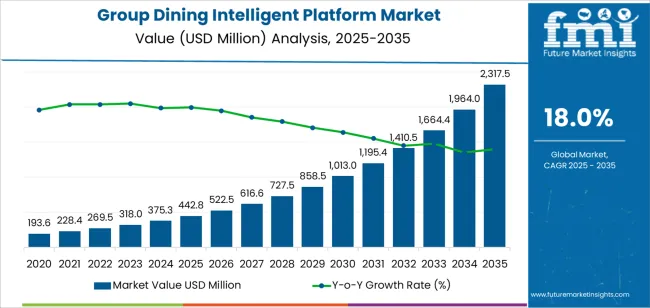
The Group Dining Intelligent Platform market exhibits distinct growth phases, each with varying market characteristics and competitive dynamics. Between 2025 and 2030, the market progresses through its technology adoption phase, expanding from USD 442.8 million to USD 1,002.5 million, with steady annual growth averaging 18.0%. This period showcases the transition from basic ordering systems to advanced digital platforms with enhanced operational management capabilities and integrated analytics systems becoming mainstream features.
The 2025-2030 phase adds USD 559.7 million to market value, representing 31% of total decade expansion. Market maturation factors include standardization of enterprise dining protocols, declining platform development costs for specialized solutions, and increasing industry awareness of the benefits of digital transformation across corporate cafeterias and institutional food service operations. The competitive landscape evolved during this period, with established food service providers like Sodexo and Compass Group expanding their digital portfolios, while technology specialists focused on advanced platform development and enhanced user experience capabilities.
From 2030 to 2035, market dynamics shift toward comprehensive system integration and global enterprise expansion, with growth continuing from USD 1,002.5 million to USD 2,266.6 million, adding USD 1,264.1 million or 69% of total expansion. This phase transition centers on intelligent back-end operations, integration with supply chain management networks, and deployment across diverse corporate and institutional scenarios, becoming standard rather than specialized applications. The competitive environment matures with focus shifting from basic digitalization capability to comprehensive operational optimization systems and integration with enterprise management platforms.
| Metric | Value |
|---|---|
| Market Value (2025) | USD 442.8 million |
| Market Forecast (2035) | USD 2,266.6 million |
| Growth Rate | 18.0% CAGR |
| Leading Technology | Digitalization of Front-End Services |
| Primary Application | Large Enterprises |
The market demonstrates strong fundamentals with front-end service digitalization systems capturing a dominant share through advanced ordering interfaces and payment optimization capabilities. Large enterprise applications drive primary demand, supported by increasing corporate dining modernization and operational efficiency requirements. Geographic expansion remains concentrated in developed markets with established corporate infrastructure, while emerging economies show accelerating adoption rates driven by enterprise digitalization and rising workplace service standards.
Market expansion rests on three fundamental shifts driving adoption across corporate, institutional, and enterprise dining sectors. First, operational efficiency demand creates compelling advantages through intelligent dining platforms that provide immediate cost reduction and service quality improvement without compromising food service standards, enabling enterprises to meet employee satisfaction requirements while maintaining budget control and reducing operational complexity. Second, workplace modernization accelerates as corporations worldwide seek advanced digital systems that complement traditional food service processes, enabling precise demand forecasting and inventory management that align with sustainability goals and operational standards.
Third, employee experience enhancement drives adoption from large enterprises and institutional operators requiring effective dining solutions that maximize service quality while maintaining operational productivity during peak service hours. However, growth faces headwinds from implementation cost challenges that vary across platform providers regarding system customization and integration requirements, which may limit adoption in budget-constrained environments. Technical limitations also persist regarding legacy system compatibility and data integration concerns that may reduce effectiveness in complex organizational scenarios, which affect platform performance and user adoption rates.
The group dining intelligent platform market represents a specialized yet critical digital transformation opportunity driven by expanding global corporate dining operations, workplace service modernization, and the need for superior operational efficiency in diverse enterprise applications. As organizations worldwide seek to achieve cost reduction, improve employee satisfaction, and integrate advanced digital systems with existing infrastructure, intelligent dining platforms are evolving from basic ordering tools to sophisticated management solutions ensuring operational excellence and service quality leadership.
The market's growth trajectory from USD 442.8 million in 2025 to USD 2,266.6 million by 2035 at an 18.0% CAGR reflects fundamental shifts in corporate workplace requirements and dining service optimization. Geographic expansion opportunities are particularly pronounced in Asia Pacific markets, while the dominance of front-end digitalization systems and large enterprise applications provides clear strategic focus areas.
Strengthening the dominant front-end digitalization segment through enhanced ordering interfaces, superior user experiences, and mobile application systems. This pathway focuses on optimizing platform usability, improving service speed, extending operational effectiveness to real-time ordering capabilities, and developing specialized interfaces for diverse applications. Market leadership consolidation through advanced user interface engineering and mobile technology integration enables premium positioning while defending competitive advantages against basic ordering systems. Expected revenue pool: USD 280-340 million
Rapid corporate workplace and enterprise dining growth across Asia Pacific creates substantial expansion opportunities through local platform deployment and technology transfer partnerships. Growing enterprise digitalization and government smart workplace initiatives drive sustained demand for advanced dining management systems. Localization strategies reduce implementation costs, enable faster technical support, and position companies advantageously for corporate procurement programs while accessing growing domestic markets. Expected revenue pool: USD 240-300 million
Expansion within the dominant large enterprise segment through specialized platform designs addressing corporate dining standards and high-volume service requirements. This pathway encompasses automated inventory systems, employee preference tracking, and compatibility with diverse enterprise resource planning processes. Premium positioning reflects superior operational management and comprehensive data analytics supporting modern corporate dining operations. Expected revenue pool: USD 220-280 million
Strategic expansion into back-end operations digitization requires enhanced system capabilities and specialized platform configurations addressing kitchen management operational requirements. This pathway addresses inventory optimization, supplier management, and food waste reduction with advanced analytics engineering for demanding operational standards. Premium pricing reflects specialized integration requirements and extended operational efficiency benefits. Expected revenue pool: USD 180-240 million
Development of specialized platform configurations for medium enterprise applications and small enterprise segments, addressing specific operational requirements and budget-sensitive deployment demands. This pathway encompasses scalable solutions, cost-effective implementations, and simplified management interfaces for emerging market segments. Technology differentiation through flexible pricing models enables diversified revenue streams while reducing dependency on large enterprise platforms. Expected revenue pool: USD 140-190 million
Expansion of comprehensive back-end systems through enhanced supplier connectivity, inventory forecasting, and procurement optimization capabilities. This pathway encompasses real-time stock management, automated ordering systems, and quality control integration requiring advanced platform architecture. Market development through supply chain engineering enables differentiated positioning while accessing operations-focused markets requiring comprehensive management solutions. Expected revenue pool: USD 120-170 million
Development of advanced analytics capabilities addressing operational optimization and decision-making requirements across corporate and institutional applications. This pathway encompasses predictive demand modeling, cost analysis systems, and comprehensive reporting functionality. Premium positioning reflects data science leadership and analytics expertise while enabling access to intelligence-focused procurement programs and performance-driven corporate partnerships. Expected revenue pool: USD 100-150 million
Primary Classification: The market segments by service type into Digitalization of Front-End Services, Digitization of Back-End Operations, and Others categories, representing the evolution from basic ordering interfaces to comprehensive operational management solutions for enterprise dining optimization.
Secondary Classification: Application segmentation divides the market into Large Enterprises, Medium Enterprises, and Small Enterprises sectors, reflecting distinct requirements for system complexity, user capacity, and operational management standards.
Regional Classification: Geographic distribution covers Asia Pacific, Europe, North America, and other regions, with developed markets leading adoption while emerging economies show accelerating growth patterns driven by corporate digitalization programs.
The segmentation structure reveals technology progression from front-end ordering systems toward comprehensive platform solutions with enhanced back-end management and analytics capabilities, while application diversity spans from large corporate installations to small enterprise deployments requiring scalable dining management solutions.

Market Position: Front-end service digitalization systems command the leading position in the Group Dining Intelligent Platform market with approximately 60.0% market share through advanced ordering interfaces, including mobile application capability, real-time menu updates, and payment optimization that enable enterprises to achieve efficient service delivery across diverse corporate and institutional environments.
Value Drivers: The segment benefits from enterprise preference for user-friendly systems that provide immediate service improvement, reduced wait times, and employee satisfaction enhancement without requiring extensive back-end modifications. Advanced interface features enable mobile ordering capabilities, customization options, and integration with existing payment systems, where user experience and service speed represent critical operational requirements.
Competitive Advantages: Front-end digitalization systems differentiate through proven usability standards, consistent platform performance, and integration with enterprise authentication systems that enhance operational effectiveness while maintaining optimal user adoption suitable for diverse corporate dining applications.
Key market characteristics:
Back-end operations digitization systems maintain strategic positioning in the Group Dining Intelligent Platform market due to their comprehensive management capabilities and operational efficiency advantages. These systems appeal to enterprises requiring complete kitchen management, inventory control, and supplier coordination for sophisticated food service operations. Market adoption is driven by operational cost reduction emphasis, featuring automated inventory management and waste reduction through optimized back-end platform systems while maintaining service quality standards.
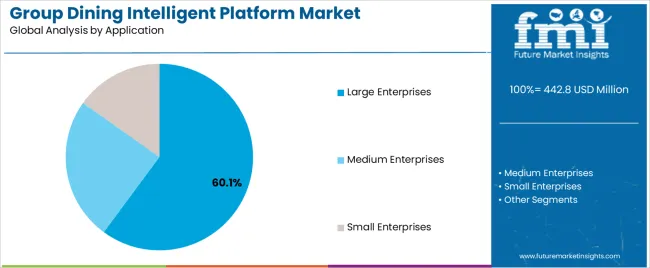
Market Context: Large enterprise applications dominate the Group Dining Intelligent Platform market with approximately 60.1% market share due to widespread adoption of comprehensive dining management platforms and increasing focus on employee satisfaction, operational efficiency, and cost control applications that minimize service disruptions while maintaining corporate dining standards.
Appeal Factors: Large enterprises prioritize system scalability, multi-location management, and integration with existing corporate infrastructure that enables coordinated platform deployment across multiple facilities. The segment benefits from substantial corporate digitalization investment and workplace modernization programs that emphasize the acquisition of intelligent dining platforms for employee experience enhancement and operational optimization applications.
Growth Drivers: Corporate workplace transformation programs incorporate intelligent dining platforms as standard infrastructure for enterprise food service operations, while employee wellness initiatives increase demand for customizable dining capabilities that comply with dietary requirements and minimize food waste.
Market Challenges: Varying corporate IT standards and organizational structure differences may limit platform standardization across different enterprise divisions or operational scenarios.
Application dynamics include:
Medium enterprise applications capture approximately 32.4% market share through tailored platform requirements in regional corporations, educational institutions, and mid-sized healthcare facilities. These organizations demand scalable systems capable of managing moderate user volumes while providing essential operational management and reporting capabilities.
Small enterprise applications account for approximately 7.5% market share, including startup companies, small office installations, and specialized food service scenarios requiring affordable platform capabilities for basic dining management and employee service needs.
Growth Accelerators: Corporate digitalization drives primary adoption as intelligent dining platforms provide superior operational efficiency capabilities that enable enterprises to meet cost reduction targets without excessive service quality compromise, supporting workplace modernization missions that require precise demand management applications. Workplace experience enhancement demand accelerates market expansion as corporations seek effective digital systems that minimize food waste while maintaining employee satisfaction during daily service operations. Enterprise IT spending increases worldwide, creating sustained demand for integrated platform systems that complement existing corporate infrastructure and provide data-driven decision making in competitive labor markets.
Growth Inhibitors: Implementation cost challenges vary across platform providers regarding system customization and integration requirements, which may limit operational flexibility and market penetration in regions with budget constraints or cost-sensitive enterprise operations. Technical performance limitations persist regarding legacy system compatibility and data migration concerns that may reduce effectiveness in complex organizational structures, affecting platform adoption and user engagement requirements. Market fragmentation across multiple enterprise IT standards and food service operations creates compatibility concerns between different platform providers and existing corporate infrastructure.
Market evolution patterns show adoption accelerating in technology companies and corporate headquarters where employee experience justifies platform investment costs, with geographic concentration in developed markets transitioning toward mainstream adoption in emerging economies driven by enterprise digitalization and workplace modernization awareness. Technology development focuses on artificial intelligence integration, predictive analytics capabilities, and compatibility with Internet of Things devices that optimize service delivery and operational effectiveness. The market could face disruption if alternative workplace service models or fully automated food service technologies significantly limit the deployment of platform-based systems in corporate applications, though digital platforms' unique combination of operational efficiency, data analytics, and user experience continues to make them preferred in enterprise settings.
The Group Dining Intelligent Platform market demonstrates varied regional dynamics with Growth Leaders including China (8.1% CAGR) and India (7.5% CAGR) driving expansion through corporate digitalization initiatives and enterprise workplace modernization programs. Steady Performers encompass Germany (6.9% CAGR), Brazil (6.3% CAGR), and United States (5.7% CAGR), benefiting from established corporate infrastructure and advanced digital transformation adoption. Mature Markets feature United Kingdom (5.1% CAGR) and Japan (4.5% CAGR), where specialized enterprise applications and workplace service integration support consistent growth patterns.
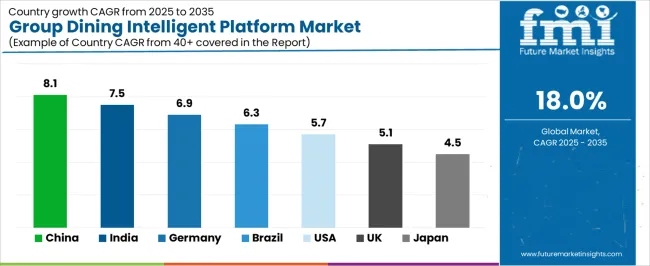
| Country | CAGR (2025-2035) |
|---|---|
| China | 8.1% |
| India | 7.5% |
| Germany | 6.9% |
| Brazil | 6.3% |
| United States | 5.7% |
| United Kingdom | 5.1% |
| Japan | 4.5% |
Regional synthesis reveals Asia Pacific markets leading adoption through corporate workplace expansion and digital platform infrastructure development, while European countries maintain steady expansion supported by enterprise technology advancement and operational efficiency standardization requirements. North American markets show moderate growth driven by employee experience applications and workplace modernization integration trends.
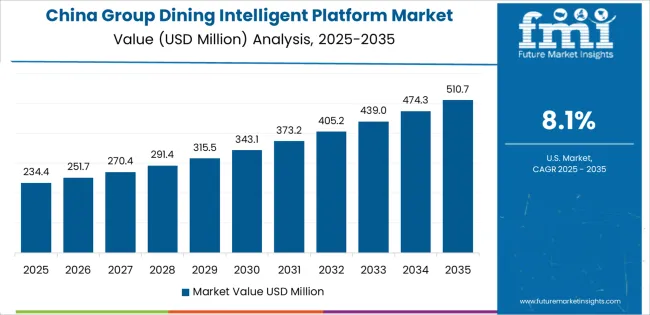
The Chinese market emphasizes advanced platform features, including artificial intelligence integration and comprehensive enterprise management systems that coordinate service delivery, inventory optimization, and employee satisfaction applications through unified digital platforms. The country demonstrates strong growth at 8.1% CAGR, driven by corporate workplace expansion, digital transformation initiatives, and emerging technology company development that support intelligent dining platform integration. Chinese enterprises prioritize operational effectiveness with dining platforms delivering consistent service quality through advanced mobile capabilities and payment system features.
Technology deployment channels include major technology corporations, manufacturing enterprises, and educational institutions that support professional applications for complex multi-site dining management and high-volume service applications. Platform integration capabilities with existing enterprise resource planning systems expand market appeal across diverse operational requirements seeking cost reduction and employee satisfaction benefits. The expanding corporate sector and accelerating workplace modernization create sustained demand, while innovative applications in smart office environments and connected workplace systems open new growth avenues.
Performance Metrics:
Germany's advanced corporate market demonstrates sophisticated platform deployment with documented operational effectiveness in enterprise dining applications and institutional food service facilities through integration with existing digital systems and corporate infrastructure. The country leverages engineering expertise in business process optimization and systems integration to maintain strong growth at 6.9% CAGR. Industrial centers, including Frankfurt, Munich, and Hamburg, showcase enterprise installations where dining platforms integrate with comprehensive workplace management systems and employee service networks to optimize corporate operations and cost effectiveness.
German enterprises prioritize system reliability and data security compliance in platform development, creating demand for certified systems with advanced features, including GDPR compliance and automated reporting systems. The market benefits from established corporate infrastructure and willingness to invest in digital workplace technologies that provide long-term operational benefits and compliance with international data protection and quality standards.
Market Intelligence Brief:
The U.S. intelligent dining platform market demonstrates sophisticated deployment across corporate applications with documented effectiveness in technology company dining and enterprise food service facilities through integration with comprehensive workplace management systems and employee experience infrastructure. The country leverages advanced technology capabilities in software development and digital platform innovation to maintain moderate growth at 5.7% CAGR. Corporate centers, including San Francisco, New York, and Seattle, showcase enterprise installations where dining platforms integrate with comprehensive workplace systems and employee benefit networks to optimize service delivery and operational effectiveness.
American corporations prioritize employee experience and data analytics in platform development, creating demand for innovative systems with advanced features, including personalized recommendation engines and predictive ordering capabilities. The market benefits from established technology infrastructure and willingness to invest in employee-focused platforms that provide long-term workplace satisfaction benefits and compliance with operational efficiency standards.
Market Intelligence Brief:
The U.K. intelligent dining platform market demonstrates advanced digital adoption with documented operational effectiveness in corporate dining applications and enterprise food service facilities through integration with existing workplace management systems and operational infrastructure. The country leverages technology expertise in digital transformation and business process optimization to maintain steady growth at 5.1% CAGR. Corporate centers, including London, Manchester, and Birmingham, showcase enterprise installations where dining platforms integrate with comprehensive employee service systems and workplace management networks to optimize operational efficiency and service effectiveness.
British enterprises prioritize system integration and operational transparency in platform development, creating demand for certified systems with advanced features, including real-time reporting and sustainability tracking. The market benefits from established corporate infrastructure and commitment to invest in digital workplace technologies that provide long-term operational benefits and compliance with UK business standards. Corporate dining applications, employee wellness systems, and sustainability-focused programs drive diversified demand across multiple enterprise segments.
Strategic Market Indicators:
India's intelligent dining platform market demonstrates rapid expansion with documented operational effectiveness in technology company dining applications and corporate food service facilities through integration with emerging digital systems and workplace modernization infrastructure. The country leverages growing technology capabilities in software development and digital platform engineering to achieve high growth at 7.5% CAGR. Corporate centers, including Mumbai, Delhi, and Bangalore, showcase expanding installations where dining platforms integrate with comprehensive workplace management systems and employee service networks to optimize operational efficiency and cost effectiveness.
Indian enterprises prioritize cost optimization and scalability standards in platform development, creating demand for flexible systems with advanced features, including multi-language support and local payment integration. The market benefits from expanding technology infrastructure and willingness to invest in digital workplace solutions that provide operational efficiency and compliance with corporate service standards.
Market Intelligence Brief:
Brazil's intelligent dining platform market demonstrates steady expansion with documented operational effectiveness in corporate dining applications and institutional food service facilities through integration with enterprise management systems and workplace service infrastructure. The country leverages developing technology capabilities in digital platform adoption and corporate modernization to maintain moderate growth at 6.3% CAGR. Corporate centers, including São Paulo, Rio de Janeiro, and Brasília, showcase growing installations where dining platforms integrate with comprehensive workplace systems and employee service networks to optimize operational management and cost control.
Brazilian enterprises prioritize operational efficiency and mobile accessibility in platform development, creating demand for adaptable systems with advanced features, including local payment methods and Portuguese language interfaces. The market benefits from expanding corporate sector and commitment to invest in workplace modernization technologies that provide operational improvements and employee satisfaction benefits.
Strategic Market Indicators:
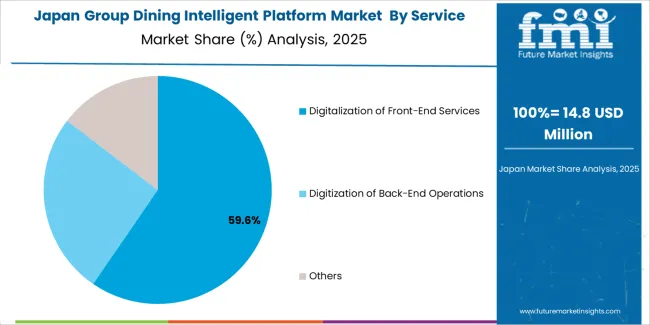
Japan's intelligent dining platform market demonstrates precision deployment with documented operational effectiveness in corporate dining applications and institutional food service facilities through integration with advanced quality management systems and operational excellence infrastructure. The country leverages engineering precision in service delivery and technology integration to maintain steady growth at 4.5% CAGR. Corporate centers, including Tokyo, Osaka, and Nagoya, showcase enterprise installations where dining platforms integrate with comprehensive quality management systems and employee service networks to optimize service excellence and operational effectiveness.
Japanese enterprises prioritize system reliability and service quality in platform development, creating demand for sophisticated systems with advanced features, including precise inventory tracking and quality assurance integration. The market benefits from established corporate infrastructure and commitment to invest in highest-quality workplace technologies that provide superior operational performance and compliance with stringent Japanese service standards.
Strategic Market Indicators:

The Group Dining Intelligent Platform market in Europe is projected to grow substantially over the forecast period, with Germany expected to maintain its leadership position with a significant market share supported by its advanced corporate infrastructure and major business centers in Frankfurt and Munich. The United Kingdom follows with strong market presence, driven by comprehensive corporate digitalization programs and workplace modernization initiatives. France holds substantial market share through specialized enterprise technology activities, financial sector applications, and corporate dining management. The Netherlands commands notable market presence through strong technology adoption and international corporate projects. Spain accounts for growing market share aided by corporate expansion and enterprise digitalization adoption. Italy maintains steady share driven by manufacturing sector applications and institutional dining demand. The Rest of Europe region is anticipated to show steady adoption, reflecting consistent growth in Nordic countries, enterprise expansion in Central European markets, and workplace modernization upgrades across Eastern European corporate facilities.
In Japan, the Group Dining Intelligent Platform market prioritizes front-end service digitalization systems, which capture the dominant share of corporate and institutional installations due to their advanced features, including precision user interface optimization and seamless integration with existing enterprise authentication infrastructure. Japanese corporate operators emphasize reliability, service quality, and long-term operational excellence, creating demand for front-end systems that provide consistent platform capabilities and superior user experience based on employee requirements and service standards. Back-end operations digitization maintains secondary positions primarily in large manufacturing enterprises and institutional food service installations where comprehensive operational management meets requirements without compromising employee satisfaction.
Market Characteristics:
How is South Korea Led by International Platform Providers?
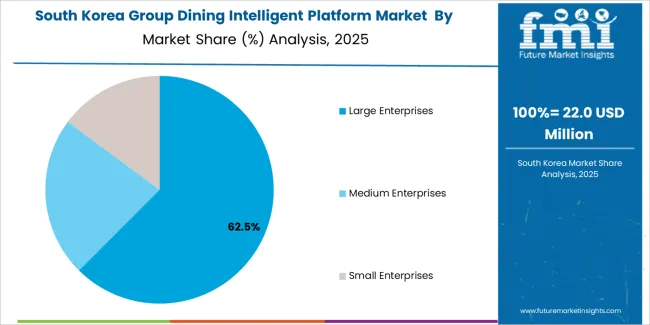
In South Korea, the market structure favors international platform providers, including ezCater and ChowNow, which maintain dominant positions through comprehensive service portfolios and established corporate networks supporting both large enterprise implementations and medium business installations. These providers offer integrated solutions combining advanced digital platform systems with professional technical support and ongoing service management that appeal to Korean corporations seeking reliable enterprise dining solutions. Local technology companies and service providers capture moderate market share by providing localized platform capabilities and competitive pricing for standard corporate dining installations, while domestic developers focus on specialized applications and cost-effective solutions tailored to Korean business market characteristics.
Channel Insights:
The Group Dining Intelligent Platform market operates with moderate concentration, featuring approximately 10-12 meaningful participants, where leading companies control roughly 50-55% of the global market share through established corporate relationships and comprehensive platform service portfolios. Competition emphasizes advanced technology capabilities, enterprise integration features, and service quality excellence rather than price-based rivalry. The leading company, ezCater, commands approximately 28.0% market share through its extensive corporate catering platform and North American enterprise presence.
Market Leaders encompass ezCater, Sodexo, and Compass Group, which maintain competitive advantages through extensive food service expertise, global corporate networks, and comprehensive platform integration capabilities that create customer loyalty and support premium pricing. These companies leverage decades of corporate dining experience and ongoing technology investments to develop advanced intelligent platform systems with user experience optimization and operational management features. Technology Innovators include ChowNow and regional specialists, which compete through specialized software development technology focus and innovative platform capabilities that appeal to enterprises seeking advanced digital solutions and service differentiation.
These companies differentiate through rapid platform development cycles and specialized corporate application focus. Regional Specialists feature technology providers focusing on specific geographic markets and specialized applications, including local payment integration and language-specific systems. Market dynamics favor participants that combine reliable platform performance with advanced operational capabilities, including predictive analytics and automated inventory optimization features. Competitive pressure intensifies as traditional food service providers expand into digital platform systems, while specialized technology companies challenge established players through innovative software solutions and cloud-based platforms targeting corporate and institutional dining segments.
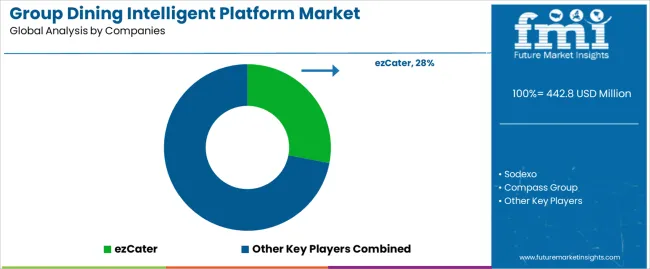
| Item | Value |
|---|---|
| Quantitative Units | USD 442.8 million |
| Service Type | Digitalization of Front-End Services, Digitization of Back-End Operations, Others |
| Application | Large Enterprises, Medium Enterprises, Small Enterprises |
| Regions Covered | Asia Pacific, Europe, North America, Latin America, Middle East & Africa |
| Countries Covered | China, India, Germany, United States, United Kingdom, Japan, Brazil, and 20+ additional countries |
| Key Companies Profiled | ezCater, Sodexo, Compass Group, ChowNow, Hungry, ZeroCater, Meican, Beijing DBN Technology Group |
| Additional Attributes | Dollar sales by service type and application categories, regional adoption trends across Asia Pacific, Europe, and North America, competitive landscape with platform providers and food service operators, enterprise preferences for operational efficiency and employee experience, integration with corporate management platforms and workplace service systems, innovations in artificial intelligence capabilities and predictive analytics, and development of mobile-first solutions with enhanced performance and user experience optimization capabilities. |
The global group dining intelligent platform market is estimated to be valued at USD 442.8 million in 2025.
The market size for the group dining intelligent platform market is projected to reach USD 2,317.5 million by 2035.
The group dining intelligent platform market is expected to grow at a 18.0% CAGR between 2025 and 2035.
The key product types in group dining intelligent platform market are digitalization of front-end services, digitization of back-end operations and others.
In terms of application, large enterprises segment to command 60.1% share in the group dining intelligent platform market in 2025.






Full Research Suite comprises of:
Market outlook & trends analysis
Interviews & case studies
Strategic recommendations
Vendor profiles & capabilities analysis
5-year forecasts
8 regions and 60+ country-level data splits
Market segment data splits
12 months of continuous data updates
DELIVERED AS:
PDF EXCEL ONLINE
Global Clinical Risk Grouping Solution Market Insights – Trends & Forecast 2024-2034
Vascular Sheath Group Market Size and Share Forecast Outlook 2025 to 2035
Chalcocite-Digenite Group Market Size and Share Forecast Outlook 2025 to 2035
Outdoor Dining Table Market Trends - Growth & Forecast 2025 to 2035
Kitchen & Dining Furniture Market
Breaking Down Market Share in Peer-to-Peer Dining Services
Peer-to-Peer Dining Market Insights - Demand & Forecast 2025 to 2035
Platform Lifts Market Size and Share Forecast Outlook 2025 to 2035
Platform Architecture Market Size and Share Forecast Outlook 2025 to 2035
Platform Boots Market Trends - Growth & Industry Outlook to 2025 to 2035
Platform Shoes Market Trends - Demand & Forecast 2025 to 2035
Platform Trolley Market Growth – Trends & Forecast 2025 to 2035
AI Platform Market Size and Share Forecast Outlook 2025 to 2035
AI Platform Cloud Service Market Size and Share Forecast Outlook 2025 to 2035
Sales Platforms Software Market Size and Share Forecast Outlook 2025 to 2035
AIOps Platform Market Forecast and Outlook 2025 to 2035
Cross-Platform & Mobile Advertising Market Report – Growth 2018-2028
RevOps Platform Market Insights – Growth & Forecast 2023-2033
DataOps Platform Market Size and Share Forecast Outlook 2025 to 2035
Battery Platforms Market Analysis Size and Share Forecast Outlook 2025 to 2035

Thank you!
You will receive an email from our Business Development Manager. Please be sure to check your SPAM/JUNK folder too.
Chat With
MaRIA